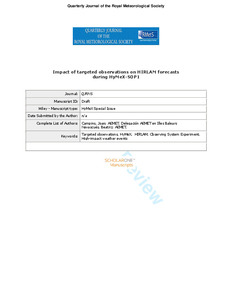Por favor, use este identificador para citar o enlazar este ítem:
http://hdl.handle.net/20.500.11765/1338
Impact of targeted observations on HIRLAM forecasts during HyMeX-SOP1
Registro completo de metadatos
| Campo DC | Valor | Lengua/Idioma |
|---|---|---|
| dc.contributor.author | Campins, Joan | es_ES |
| dc.contributor.author | Navascués, Beatriz | es_ES |
| dc.date.accessioned | 2016-03-17T11:00:30Z | - |
| dc.date.available | 2016-03-17T11:00:30Z | - |
| dc.date.issued | 2016 | - |
| dc.identifier.citation | Quarterly Journal of the Royal Meteorological Society. 2016, 142, p. 363–376 | es_ES |
| dc.identifier.issn | 0035-9009 | - |
| dc.identifier.issn | 1477-870X | - |
| dc.identifier.uri | http://hdl.handle.net/20.500.11765/1338 | - |
| dc.description.abstract | An adaptive observing system with terrestrial and space-based components has been explored, with the aim of improving numerical weather prediction skill in the Mediterranean. Four Observing System Experiments based on the HIRLAM system have been conducted to test the influence of targeted observations on short-term forecasts of high-impact weather events over the first Special Observation Period of the HyMeX international project. Extra radiosoundings and enhanced Advanced TIROS Operational Vertical Sounder (ATOVS) satellite observations are assimilated as targeted observations, and have been added to the baseline first separately and then jointly. In general, targeted observations have a positive but small impact on the short-term forecasts, noticeably at 700 to 500 hPa in all parameters and precipitation. Targeted radiosoundings produce a clear overall improvement of HIRLAM forecasts. Data targeting based only on satellite observations has a generally positive impact on precipitation, and in short-term forecasts of the rest of the parameters. The assimilation of both types of extra observations produces the highest and most statistically significant improvements. The magnitude of the impact on the forecasts depends on the weather regime that determines the location of sensitive areas. According to the diagnostics obtained from the data assimilation cycle, the targeted observations had a still larger positive influence on the subsequent analyses. Extra radiosoundings and additional satellite radiances clearly improve the first-guess quality over land and sea sensitive areas respectively. | es_ES |
| dc.description.sponsorship | This work has been partially supported by PREDIMED (CLI-CGL2011-24458) Project. | - |
| dc.format | application/pdf | - |
| dc.language.iso | eng | es_ES |
| dc.publisher | Wiley | es_ES |
| dc.publisher | Royal Meteorological Society | - |
| dc.subject | Targeted observations | - |
| dc.subject | Observing system experiments | - |
| dc.subject | Weather events | - |
| dc.subject | HIRLAM | es_ES |
| dc.subject | HyMeX | es_ES |
| dc.subject | Mediterráneo | es_ES |
| dc.title | Impact of targeted observations on HIRLAM forecasts during HyMeX-SOP1 | es_ES |
| dc.type | info:eu-repo/semantics/article | es_ES |
| dc.relation.publisherversion | https://dx.doi.org/10.1002/qj.2737 | es_ES |
| dc.rights.accessRights | info:eu-repo/semantics/openAccess | es_ES |
| Colecciones: | Artículos científicos 2015-2018 | |
Ficheros en este ítem:
| Fichero | Descripción | Tamaño | Formato | ||
|---|---|---|---|---|---|
| campins_et_al_qjrms_2... | 2,06 MB | Adobe PDF |  Visualizar/Abrir |
Los ítems de Arcimis están protegidos por una Licencia Creative Commons, salvo que se indique lo contrario.





